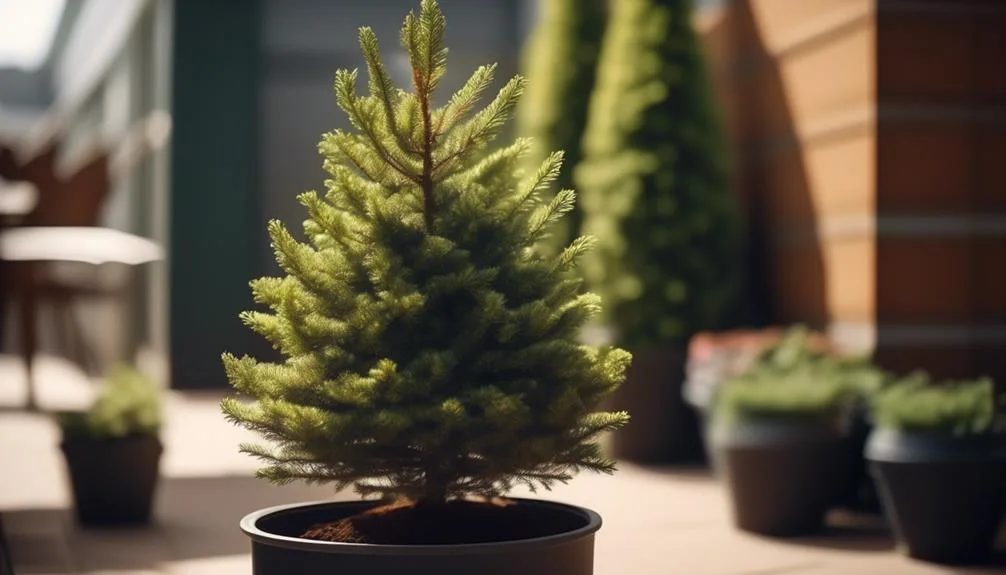Wondering if you can grow a spruce tree in a pot? Surprisingly, it's doable! Whether you lack outdoor space or want greenery on your patio, growing spruce trees in containers can be fulfilling.
However, there are important factors to consider, from the right container to specific care requirements. Container gardening for spruce trees is both challenging and rewarding.
Learn more about this unique gardening endeavor and how to get started.
Benefits of Growing Spruce Trees in Containers
You'll find that growing spruce trees in containers offers numerous benefits for both urban and rural gardeners.
Firstly, there's the space-saving advantage. In urban areas where outdoor space is limited, container gardening provides a practical solution. You can place the containers on balconies, patios, or even indoors, allowing you to enjoy the beauty of spruce trees without needing a large garden.
Additionally, mobility advantages come into play. With container-grown spruce trees, you have the flexibility to move them around as needed. This means you can easily rearrange your outdoor space, protect the trees from extreme weather, or transport them to a new location if you move.
These benefits make growing spruce trees in containers a versatile and convenient option for gardeners of all kinds.
Selecting the Right Container for Spruce Trees
Selecting the right container for your spruce trees is crucial for maximizing the benefits of container gardening, especially in urban areas where outdoor space is limited. When choosing a container for your spruce trees, consider the size, material, and drainage.
The container should be large enough to accommodate the mature size of the spruce tree, allowing ample space for root growth. Opt for containers made of durable materials like plastic, fiberglass, or concrete, as they provide insulation and prevent the roots from overheating. Additionally, ensure the container has adequate drainage holes to prevent waterlogging, which can lead to root rot.
Place the container in an area that receives sufficient sunlight and provides the right temperature for spruce tree growth. By carefully selecting the container, you can create an ideal environment for your spruce trees to thrive in a limited space.
Essential Soil and Watering Considerations
What are the key soil and watering considerations to ensure the successful growth of spruce trees in containers?
The soil composition is crucial for spruce trees in containers. Use a well-draining mix, such as a combination of peat moss, pine bark, and perlite, to provide good aeration and moisture retention. This helps prevent waterlogged roots, which can lead to root rot. Additionally, incorporating slow-release fertilizer into the soil can provide essential nutrients over an extended period.
When it comes to watering frequency, it's important to strike a balance. While spruce trees require regular watering, allowing the soil to dry out slightly between waterings can help prevent overwatering. Aim to water when the top inch of soil feels dry, but be mindful not to let the soil dry out completely.
Maintaining and Pruning Container-Grown Spruce Trees
When maintaining and pruning container-grown spruce trees, regularly inspect the branches for any signs of disease or damage. Pruning techniques are essential for maintaining the health and shape of the tree. Use clean, sharp pruning shears to remove any dead, diseased, or crossing branches. Be mindful of the tree's natural shape and avoid cutting into the woody parts of the branches. Additionally, root management is crucial for container-grown spruce trees. Periodically check the roots and repot the tree into a slightly larger container if the roots become crowded. Here's a helpful table summarizing essential maintenance and pruning practices:
| Maintenance Tips | Pruning Techniques | Root Management |
|---|---|---|
| Regular branch inspection | Use clean, sharp tools | Check roots periodically |
| Disease and damage check | Remove dead or diseased | Repot if roots are crowded |
| Shape maintenance | Avoid cutting woody parts | Transplant into larger pot |
Maintaining and pruning container-grown spruce trees is essential for their overall health and longevity.
Potential Challenges and Solutions for Container Gardening
Facing challenges in container gardening is a natural part of cultivating healthy and thriving plants. It's important to be prepared with effective solutions to ensure the success of your container-grown spruce trees. Here are some potential challenges you may encounter and creative solutions to overcome them:
- Space Limitations: If you're limited on space, consider using vertical planters or tiered shelving to maximize the use of vertical space.
- Root Bound: To prevent root binding, regularly check the root system and consider repotting into a larger container if the roots are becoming crowded.
- Watering Issues: Use self-watering containers or create a watering schedule to ensure your spruce trees receive adequate moisture without the risk of overwatering.
- Nutrient Depletion: Incorporate slow-release fertilizers or organic compost to replenish essential nutrients in the soil and promote healthy growth.
Conclusion
Incorporating spruce trees into your container garden is an achievable and rewarding endeavor. By selecting the right container, soil, and watering methods, you can nurture healthy spruce trees.
Ongoing maintenance and pruning are essential, and while challenges may arise, with attentive care, the beauty of spruce trees can thrive in your container garden.

My interest in trees started when I first saw the giant sequoias in Yosemite.
I was a teenager then, and I remember thinking, “I need to learn more about this.”
That moment stuck with me.
A few years later, I went on to study forestry at Michigan Tech.
Since graduating, I’ve worked in a mix of hands-on tree care and community education.
I’ve spent over ten years helping people understand how to plant, maintain, and protect the trees in their neighborhoods.
I don’t see trees as just part of the landscape.
They are living things that make a real difference in our daily lives.
